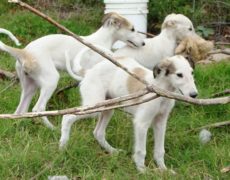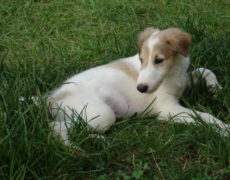Borzoi (Russian Wolfhound)
The domestic breed named Borzoi, originating in the then USSR (now, Russia) was bred and brought in to the country with many features common to the greyhound. The borzoi, adorned with a silky coat, stoutly-built physique, narrow skull structure, and a head ending in a large black nose atop an elongated muzzle, have been an addition to the hunting-hound list by virtue of the gifted talent of their wondrous senses of smell and vision.
Borzoi Pictures
- Black and White Borzoi
- Black Borzoi
- Borzoi Face
- Borzoi Head
- Borzoi Images
- Borzoi Mix
- Borzoi Photos
- Borzoi Pictures
- Borzoi Puppies
- Borzoi Puppy Images
- Borzoi Puppy Photos
- Borzoi Puppy Pictures
- Borzoi Puppy
- Borzoi Running
- Borzoi
- Russian Wolfhound
- White Borzoi
- White with Brown Coated Borzoi
Quick Information
| Other Nicknames | Russian Wolfhound |
| Coat | Long, silky |
| Color | Black, white, grey, red (combinations) |
| Group (of Breed) | Hound (sighthound) |
| Lifespan | 10 to 12 years |
| Weight | 100 – 120 pounds |
| Height (size) | Large; 30 – 35 inches |
| Shedding | Average |
| Temperament | Quiet, athletic, intelligent, independent, gentle |
| Good with Child | No |
| Litter Size | 1 – 11 puppies at a time |
| Hypoallergenic | No |
| Drooling | Yes |
| Barking | Very moderate |
| Originated in | Russia, Belarus |
| Competitive Registration | CKC, FCI, AKC, UKC, KCGB, CKC, ANKC, NKC, NZKC, BCUK, APRI, ACR, DRA, NAPR, ACA |
Borzoi Video
History
Bred by the Russian nobles back in the 1650s, the formerly popular ‘Russian Wolfhound’ is believed to have been developed from the Russian Bearhounds, and had been mentioned in works of art like in many literary pieces, paintings etc.
Mixes
The most common mixes of the Borzoi by the breeders are those with the Collie, the Whippet, the Husky, the German Shepherd etc.
Temperament and Behavior
Unlike most dogs, these free-thinking dogs are not much prone to pleasing the humans, but can learn to be obedient, if trained as a puppy. Although sweet and loyal, they aren’t good with children and strangers and would be aggressive with anything moving, like small pets and animals like rabbit, hamster, cat etc. However, they interact comparatively better with other dog breeds. By nature, they are clean, and would constantly be busy cleaning themselves like cats.
Care
Exercise
In order to balance their hunting instincts and keep them away from being aggressive at adult age, the borzois need vigorous exercises daily. Being a great jogging companion, you can take it out for jogging running with your bicycle, however, enough care must be taken because they might disappear while running after any passing animal. Allow them to play unleashed in an enclosed area, since they do need to run and play in order to ensure fitness.
Grooming
Borzois demand good attention. Firm-bristle brushing of their long coat should be done thoroughly to retain the natural grace. Being seasonal shedders, they need being dry-shampooed when necessary, but not being bathed frequently. Keeping an eye for any possible ear, skin or eye redness or infections, and on the growth of their toenails is necessary.
Health Problems
Being sensitive to drugs, you need to consult the vet before any medication. Drug Ropum (Xylazine) must never be used for this breed. Never allow them to hover over lawns chemically-treated recently, nor where fertilizers have been used. Being an uncommon breed, take your time to find the best breeders before adopting your borzoi puppy. They are also prone to common dog diseases like PRA (Progressive Retinal Atrophy), OCD (Osteochondrosis Dissecans), etc.
Training
For best results, train your puppy from the time when your own kid too is still a child. Train it to get used to its leash and also to consider you as its ‘pack-leader’ by leading it wherever you go. Train them consistently, but never rudely, for not chasing other animals, and about dog etiquettes and the differences between right and wrong by setting distinct rules. Professional or kindergarten training is also advisable.
Feeding
4-8 cups of high quality dry dog food is recommended, divided into equal halves for their main meals. Three halves is also recommended, if your dog is prone to eating too much, but never more. Bloating and other gastroenterological problems being common issues with this breed, a proper amount of diet is advisable, rather than large meals, especially after their exercise regimes.
Interesting Facts
- The first registered Borzoi, named Princess Irma, was by the American Kennel Club in 1891.
- The name of this breed was changed in 1936 from ‘Russian Wolfhound’ to ‘Borzoi’.
- Borzoi ranks 96th among all 155 AKC-registered breeds.
- Actually the borzoi is not dangerous with children, but that, it becomes nervous around kids, and thus, becoming fussy.























